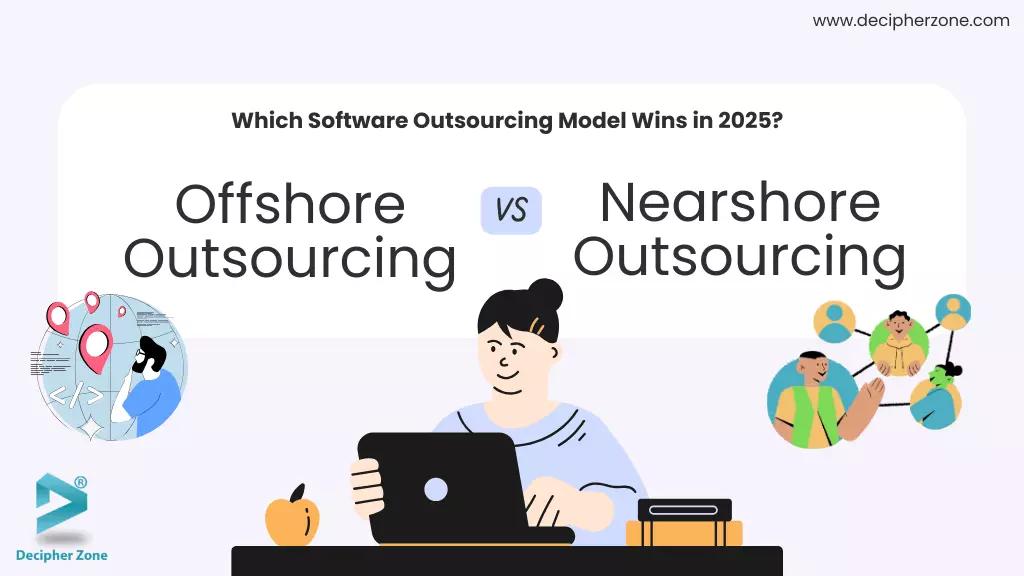Quick Summary:
When it comes to choosing the right outsourcing model for your project, whether it’s for Software Development, Customer Support, Data Entry, Call Centers, or Agile Projects the choice needs to be well thought out. Considering all the factors, benefits and potential challenges.
This blog is a detailed guide for Offshore vs Nearshore outsourcing models including all the aspects from advantages to disadvantages, comparison, ideal projects, and challenges. By the time you finish reading this article, you will be equipped to make an informed decision.
Businesses like yours are constantly on the lookout for smarter, faster and more efficient ways to build and scale their software products. Outsourcing has emerged as a strategic lever not just to cut costs but to explore access to global tech talent may be to speed up development cycles and bring innovation to market faster than ever.
With the global IT outsourcing market projected to soar to $770.98 billion by 2032, businesses of all sizes are re-evaluating their outsourcing strategies to stay ahead of the curve. When it comes to choosing two models dominate the conversation: offshore and nearshore software outsourcing.
Offshore outsourcing connects businesses with talent in geographically distant regions offering several advantages like cost savings and 24/7 development cycles. Nearshore outsourcing focuses on closer collaboration with teams in nearby countries often within similar time zones and cultural contexts.
Wondering which model is right for your business? Is it better to optimize costs and tap into a global workforce or prioritize real-time collaboration and cultural proximity? This blog explores:
-
Understanding of both offshore and nearshore outsourcing models,
-
Key difference between offshore and nearshore outsourcing,
-
Pros and cons of each software outsourcing model,
-
Ideal project types for offshore and nearshore outsourcing,
-
Challenges businesses face while outsourcing,
-
And how Decipher Zone can be your ideal partner?
Whether you’re planning to scale your software development team, speed up your product roadmap or explore new market opportunities, this guide will help you make a well informed decision tailored to your goals.
Understanding Software Development Outsourcing Models
Software outsourcing models are diverse and can be categorized by location, relationship and contract type. These models offer different approaches to engaging external teams for software development each with its own advantages and disadvantages.
Basically there are three types of location-based outsourcing models.
Offshore Outsourcing Model Vs Nearshore Outsourcing Model
In this article, we are comparing the two Offshore and Nearshore.
1. Offshore Software Development Outsourcing Model
In Offshore outsourcing, businesses partner with development teams located in distant countries often across multiple time zones to delegate software development and other IT-related tasks. This model has long been a go-to strategy for organizations looking to scale faster, reduce operational costs and tap into specialized global expertise.
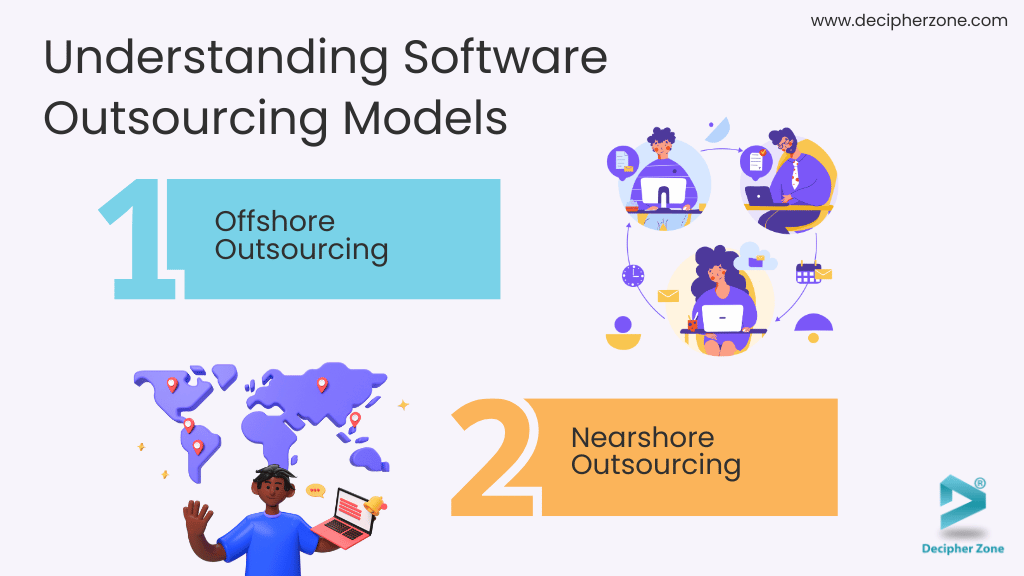
Mainly, offshore outsourcing connects businesses in North America or Europe with teams in regions such as India, the Philippines, Eastern Europe or Vietnam. The appeal lies in significantly lower labor costs and the ability to access a vast and highly skilled talent pool without the overhead of local hiring.
Read: Choose Offshore Software Development Team
This approach allows 24/7 productivity as teams work while your internal operations are offline, accelerating development timeframes. With these several advantages come certain challenges such as navigating time zone mismatches, cultural differences and communication barriers that can affect collaboration and overall project results.
Even after these challenges, offshore outsourcing remains a powerful model when managed with the right tools, processes and cultural alignment. As we move further into 2025, it continues to evolve fueled by digital collaboration platforms, agile development practices and a global shift toward remote work.
For businesses willing to invest in seamless communication and long-term relationships offshore outsourcing offers immense potential to drive innovation and growth.
2. Nearshore Software Development Outsourcing Model
About nearshore it is the preferred choice for businesses seeking a balance between cost-effectiveness. Nearshore outsourcing involves partnering with software development teams located in nearby or neighboring countries mainly within the same or adjacent time zones. This geographic proximity allows smoother communication, more responsive collaboration and even there is possibility of in-person visits when required.
Nearshore is perfect for businesses that hesitate to work with teams halfway across the globe. This model presents a practical solution. The time zone alignment often differs by just one or two hours which means your internal and external teams can work together in real time. This can streamline daily operations and significantly reduce project delays caused by asynchronous communication.
While the cost savings can be not as dramatic as offshore outsourcing, nearshoring still offers competitive development rates and the added value of fewer cultural and language barriers.
Development partners in nearshore locations often share similar business practices, work ethics and communication styles which not only build stronger but more cohesive working relationships.
Advantages & Disadvantages of Offshore and Nearshore Software Development Outsourcing Models
Choosing the right outsourcing model is not only about cost but also about finding the best fit for your project’s complexity, communication needs and long-term growth plans. Both offshore and nearshore outsourcing offer unique advantages that can drive significant business value but they also come with their own set of disadvantages.
To help you make more informed decisions, let’s make it more clearer picture of the pros and cons of each model in the table below:
|
Outsourcing Models |
Advantages |
Disadvantages |
|
Offshore Outsourcing |
|
|
|
Nearshore Outsourcing |
|
|
Comparison: Offshore vs Nearshore Software Development Outsourcing Models
Businesses aim to optimize costs, enhance collaboration and access specialized talent. Both offshore and nearshore outsourcing offer distinct advantages and disadvantages.
Here is a detailed comparison:
Comparison 1: Budget
|
Offshore Outsourcing |
Nearshore Outsourcing |
|
Highly cost-effective. |
Cost-effective but slightly more expensive. |
Offshore Outsourcing: Offers cost savings from lower labor costs in countries such as India, the Philippines and Vietnam. But potential hidden costs including travel, training and communication tools must be considered.
Nearshore Outsourcing: While nearshore is not as inexpensive as offshore but it still provides cost benefits compared to other outsourcing models. Improved communication and reduced travel expenses can compensate for slightly higher prices.
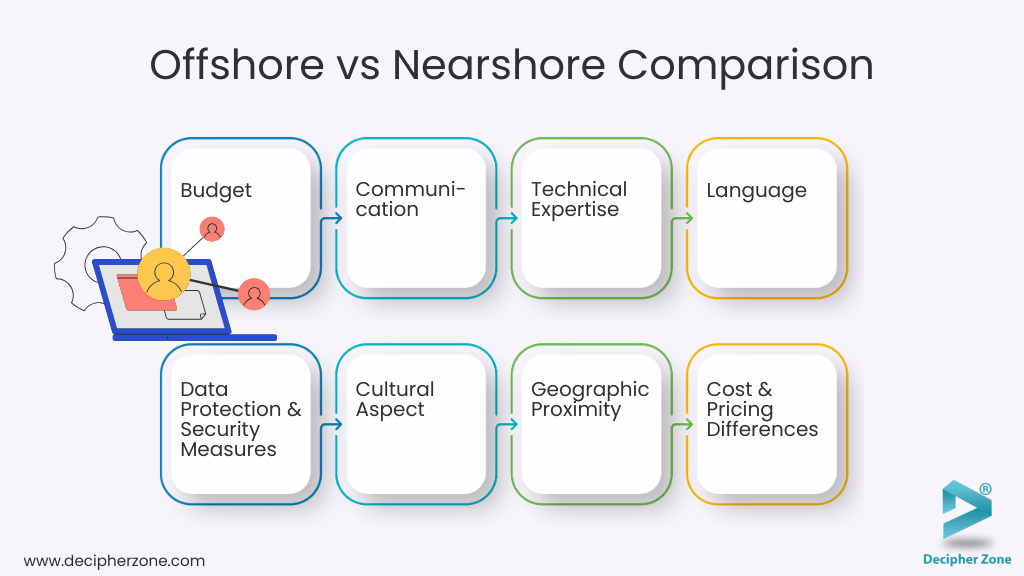
Comparison 2: Communication
|
Offshore Outsourcing |
Nearshore Outsourcing |
|
Significant time zone differences can delay communication. |
Minimal time zone difference but real-time collaboration. |
Offshore Outsourcing: Time zone differences can hamper real time communication which leads to delays and potential misunderstandings. Scheduled meetings often require flexibility from both parties.
Nearshore Outsourcing: Minimal time zone differences enhance real-time collaboration which allows teams to communicate effectively and provide quicker feedback resulting in more efficient project management and streamlined workflows.
Comparison 3: Technical Expertise
|
Offshore Outsourcing |
Nearshore Outsourcing |
|
Access to a vast global talent pool with diverse technical expertise. |
Skilled workforce closely aligned with Western business practices. |
Offshore Outsourcing: Businesses have access to a vast global talent pool with diverse technical skills. Countries like India and Ukraine are renowned for their IT expertise.
💡 Ready to Choose the Right Outsourcing Model for Your Business?
Nearshore Outsourcing: offering a skilled workforce specifically in regions like Latin America and Eastern Europe. While the talent pool might be smaller than offshore as it often aligns more closely with Western business practices.
Comparison 4: Language
|
Offshore Outsourcing |
Nearshore Outsourcing |
|
Language barriers depend on the region. |
Higher chance of language compatibility |
Offshore Outsourcing: Language barriers can be challenging as it depends on the region where team members may not share a common language. Miscommunication can easily arise if teammates aren’t proficient in a shared language, leading to misunderstandings and complications.
Read: Nearshore Software Development
Nearshore Outsourcing: More chances of finding language compatibility particularly when outsourcing to neighboring countries that share similar languages or have the level of English proficiency to lead a proper communication.
Comparison 5: Data Protection & Security Measures
|
Offshore Outsourcing |
Nearshore Outsourcing |
|
Complex compliance due to varying international data protection laws. |
Similar or shared data protection regulations simplify compliance. |
Offshore Outsourcing: Navigating different data protection laws and regulations can make compliance quite complicated. It’s crucial to verify that offshore partners comply with international security standards.
Nearshore Outsourcing: Being close to proximity usually pimples that there are similar or shared data protection regulations in place. This alignment can simplify compliance efforts and help to reduce regulatory standards complexities.
Comparison 6: Cultural Aspect
|
Offshore Outsourcing |
Nearshore Outsourcing |
|
Has cultural differences that can impact work styles and communication. |
Has stronger cultural alignment with similar business ethics. |
Offshore Outsourcing: Cultural differences can impact work styles, communication and business expectations. These variations can lead to misunderstandings if not recognized and addressed appropriately. Understanding and respecting these differences is crucial for boosting effective collaboration and improving workplace dynamics.
Nearshore Outsourcing: In nearshore, the neighboring countries share greater cultural alignment, leading to smoother collaboration, shared business ethics and mutual understandings.
Comparison 7: Geographic Proximity
|
Offshore Outsourcing |
Nearshore Outsourcing |
|
Challenging travel with higher costs and extended travel times. |
Easy travel accessibility that allows frequent face-to-face meetings and builds stronger relationships. |
Offshore Outsourcing: Geographical distance can make in-person meetings challenging which leads to higher travel costs and extended time away.
Nearshore Outsourcing: Closer proximity enables for easier travel, facilitates face-to-face interactions and stronger relationship building.
Comparison 8: Cost & Pricing Differences
|
Offshore Outsourcing |
Nearshore Outsourcing |
|
Most affordable option but may involve hidden costs like travel and training. |
Balanced operational efficiency with slightly higher costs. |
Offshore Outsourcing: With low wages and operational expenses offshore outsourcing allows for the development of the most affordable software solutions in specific countries.
Nearshore Outsourcing: Offering a perfect balance of cost savings and operational efficiency but slightly more expensive than offshore. This results in better overall value.
Both offshore and nearshore outsourcing models are ideal depending on the business's priorities. These outsourcing models offer several advantages. Your choice should align with your company’s specific needs, project requirements and long-term strategic goals.
If you need further information on what an ideal project list is while choosing the right outsourcing model or have specific questions. Continue reading as the next section is all about the ideal project types for both offshore and nearshore outsourcing.
Read: Pros and Cons of Nearshore Outsourcing
Ideal Project Types for Offshore Software Development Outsourcing
Offshore outsourcing is ideal for a variety of projects that benefit from lower labor costs, specialized skills or the ability to scale resources quickly. Industries like Manufacturing and Production, Call Centers and Business Process Outsourcing (BPO), Data Entry and Administrative Support, Textile and Apparel and Software Testing and Quality Assurance all stand to gain from these advantages.
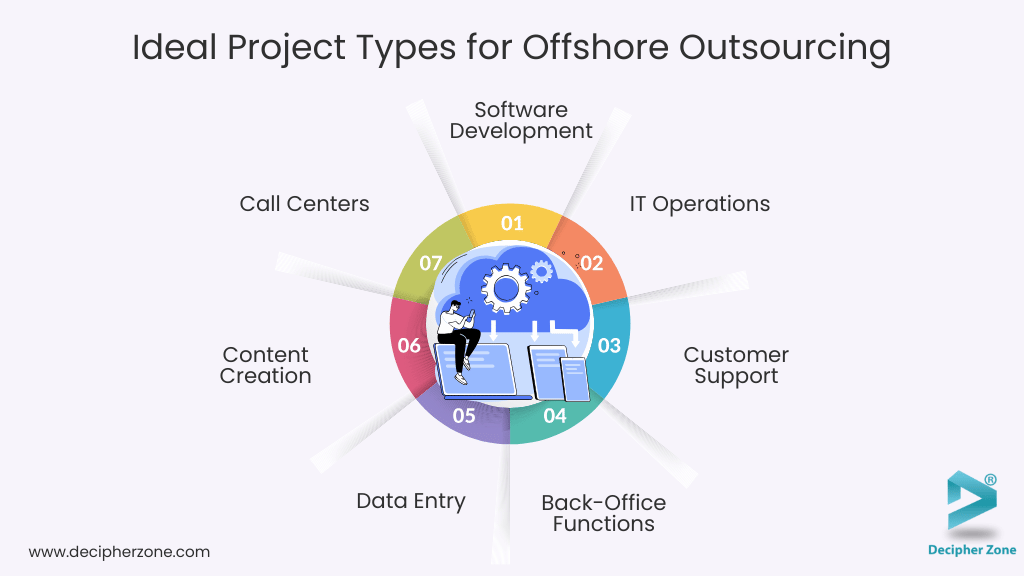
Here are some of the ideal projects in which offshore outsourcing excels:
-
Software Development: Building, maintaining and upgrading software apps, or web apps.
-
IT Operations: Managing IT infrastructure like networking and support.
-
Customer Support: Providing customer service, technical assistance and other support functions.
-
Back-Office Functions: Tasks including accounting, HR, payroll etc.
-
Data Entry: Recording and managing a large amount of data.
-
Content Creation: Writing, editing and designing content for various platforms.
-
Call Centers: Handling customer inquiries and support.
Ideal Project Types for NearshoreSoftware Development Outsourcing
Nearshore outsourcing is ideal for projects that involve frequent collaboration, real-time communication and a degree of cultural and language similarity with the client. These projects often involve agile development that requires a more collaborative approach and benefits from proximity for quick response times.
This approach mainly benefits industries like Information Technology (IT), Software Development, Customer Support and Service Centers, Creative Services and Fintech and Accounting Services.
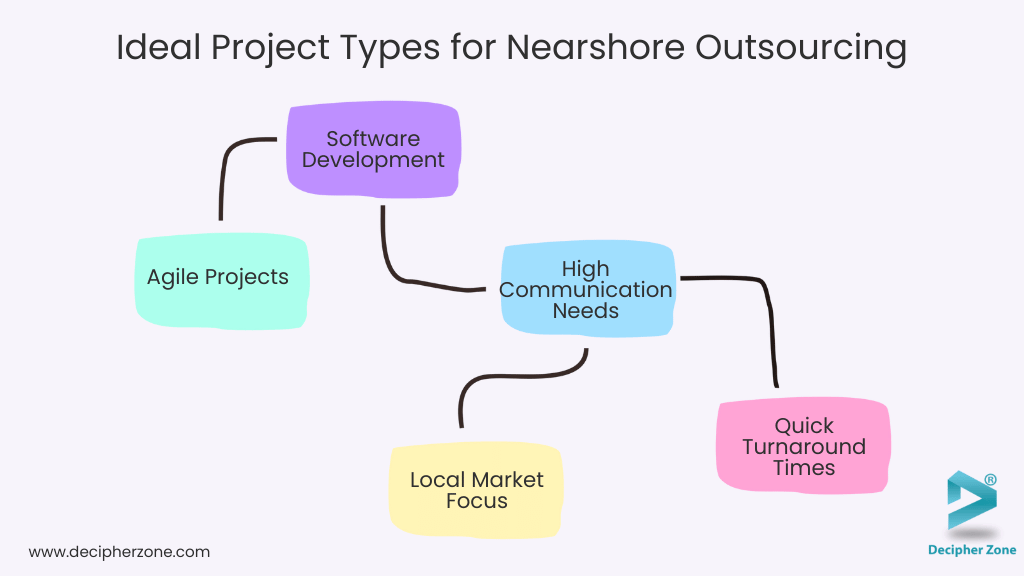
Below is the list of ideal projects for nearshore outsourcing:
-
Software Development: Development of new software solutions, modernization of existing legacy systems and custom software apps.
-
Agile Projects: The close proximity and shared time zone of nearshore teams allow the iterative and collaborative nature of agile development methodologies.
-
High Communication Needs: projects where frequent communication, brainstorming sessions and real-time collaboration are crucial.
-
Local Market Focus: projects involving specific regions where the team can leverage its understanding of local context and cultural nuances.
-
Quick Turnaround Times: for faster project execution and quicker responses to client needs.
Challenges Businesses Face in Offshore & Nearshore Software Development Outsourcing
Outsourcing models present several challenges for businesses that can hinder the successful development of software. Here is the detailed list of challenges for both offshore and nearshore outsourcing:
Challenges of Offshore Software Develooment Outsourcing Model
1. Communication Barriers
The communication can be hindered due to differences in time zones, language and cultural norms between the outsourcing company and the offshore team. These factors can create misunderstandings and delays.
Solution: The differences can be sorted by implementing robust communication strategies like the use of collaboration tools, regular meetings scheduled at manually convenient times and clear documentation of processes and expectations.
2. Quality Control
While managing teams across different countries ensuring that the quality is consistent can be challenging. Variations in work standards and practices can affect the final product.
Solution: By establishing strong monitoring, quality assurance systems, setting clear quality benchmarks and conducting regular reviews to maintain high standards.
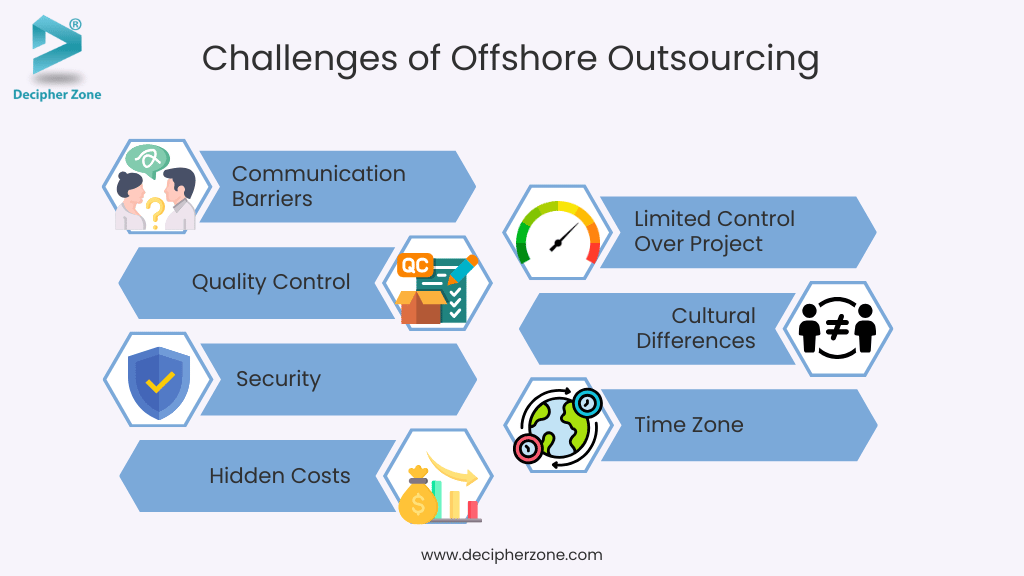
3. Security
Sharing sensitive data with offshore partners can raise concerns about data protection especially when dealing with different international regulations.
Solution: Ensure that offshore partners comply with international security standards and data protection laws. Implementing non-disclosure agreements (NDAs) and conducting regular security audits to prevent any security issues.
4. Hidden Costs
While offshore outsourcing is often pursued for cost savings, unforeseen expenses like travel, training and communication tools can accumulate.
Solution: By conducting a thorough cost-benefit analysis before engaging with offshore partners. Include potential hidden costs in budgeting and maintain transparency with vendors regarding all expenses.
5. Limited Control Over Project
Managing projects remotely can cause loss of control over the development process and timelines.
Solution: By the use of project management tools to track progress, maintain transparency, establish clear governance structures and maintain regular communication to stay informed about project developments.
6. Cultural Differences
Differences in cultural norms and business practices can affect collaboration and mutual understanding between teams.
Solution: Investing in cultural training for both in-house and offshore teams to boost mutual respect and understanding. This encourages open dialogue to bridge cultural gaps.
7. Time Zone
Real-time collaboration and prompt communication can be disturbed by significant time differences.
Solution: By planning overlapping working hours where possible and scheduling regular meetings during these periods. Also by leveraging asynchronous communication tools to keep all team members informed.
Read: Offshore Software Development
Challenges of Nearshore Software Development Outsourcing Model
1. Communication Barriers
Even with better English proficiency in many nearshore countries communication challenges can still arise. Misinterpretations, unclear instructions or lack of context can disrupt the flow of collaboration.
Solution: By choosing partners with proven communication protocols and strong language skills. Conducting regular video conferences and using detailed documentation and shared project management tools to track progress and to avoid misalignment.
2. Cultural Differences
Cultural nuances from business etiquette to communication styles can influence collaboration, team dynamics and decision-making.
Solution: By boosting cultural awareness through onboarding and mutual knowledge exchange. Choose partners with prior experience working with companies from your region along with encouraging open dialogue about working preferences to promote a shared understanding.
.avif)
3. Cost Considerations
Nearshore is often more cost-effective than hiring locally but more expensive than the offshore option.
Solution: Focus on long-term value and productivity which significantly balances costs along with benefits including improved communication and faster turnaround times.
4. Hidden Costs
Hidden costs like travel costs, visa processing, infrastructure setup and occasional delays can lead to unexpected expenses.
Solution: Choose vendors that offer transparency in pricing and detailed cost breakdowns with minimizing in-person meetings unless necessary by utilizing remote tools. Consider all potential overheads during budgeting and contract negotiations.
5. Quality Control
Maintaining consistent quality standards across borders can be challenging without strong processes in place.
Solution: By clearly defining benchmarks and KPIs to track quality at every stage. Implementing a continuous feedback loop and detailed quality processes. Using regular demos and review cycles to monitor deliverables.
6. Limited Talent Pool
Nearshore markets at some places have fewer experts in niche or emerging technologies which limits your access to specialized talent.
Solution: You can expand your talent search, focus on partners with demonstrated expertise or consider hybrid teams for advanced roles in your required tech stack.
How Decipher Zone Can Be Your Ideal Partner in Software Development Outsourcing?
Choosing the right outsourcing partner is just as critical as choosing the right outsourcing model. Whether you choose offshore to optimize costs or prefer nearshore to enhance collaboration, Decipher Zone is uniquely positioned to support your business across both models with excellence, agility and reliability.
Here are the 6 reasons you should choose DZ:
1. Dual Expertise in Offshore & Nearshore Models
Decipher Zone brings over a decade of experience in delivering robust software solutions through both offshore and nearshore development teams. We understand the nuanced challenges and opportunities that come with each model and provide a customized engagement approach tailored to your goals, location and communication needs.
2. Agile-First Approach Development
Our team follows agile methodologies to ensure real time visibility, frequent iterations and faster time to market. Whether your team is across continents or just a few hours away. Our developers are skilled in agile project delivery and work collaboratively with your internal team to meet shifting priorities and tight deadlines.
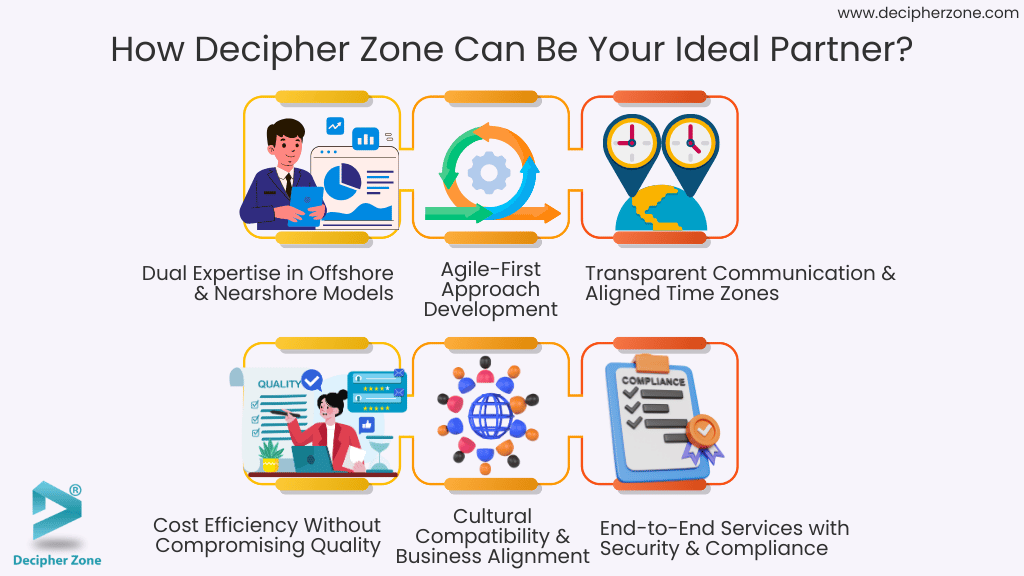
3. Transparent Communication & Aligned Time Zones
We offer flexible options that minimize time zone friction while maximizing daily collaboration. Our team including project managers and tech stack leads are remotely located globally, ensuring seamless communication, clear documentation and proactive updates to keep the project on track.
Read: Benefits of Hiring a Software Development Company
4. Cost Efficiency Without Compromising Quality
With our strategic approach we help businesses significantly cut down on development costs without compromising code quality or even innovation. From MVPs to enterprise-grade platforms, we ensure your product is built to not just scale but also secure and aligned with global standards.
5. Cultural Compatibility & Business Alignment
At Decipher Zone, we emphasize cultural training, mutual understanding and business ethics that resonate with Western partners. Our teams adapt quickly to the work culture and deliver with accountability and ownership, building long-term partnerships rather than one-time engagements.
6. End-to-End Services with Security & Compliance
We offer end-to-end software development services from ideation to UI/ UX, development, QA deployment and ongoing support. Our practices are aligned with GDPR, HIPAA and other major data protection frameworks to ensure the product remains secure and compliant.
👉 Let’s talk about your project needs today.
📩 Get in touch with our experts now or schedule a free consultation.
🚀 The right team, the right model, and the right results—start here.
FAQs
-
What does a nearshore software development team mean?
Nearshore software development team is software development work to a team located in a neighboring country or similar to the time zone or culturally based. This outsourcing model offers several benefits like cost saving, access to specialized talent, easier communication and collaboration due to geographical proximity and near to the same time zones.
-
What does an offshore software development team mean?
Offshore software development team is a group of software developers, project managers, and testers who are geographically located in a different country or region than the company or client they are working for. This outsourcing model is utilized to perform software development tasks including reduced costs, access to a wide pool of talent and leveraging specialized skills.
-
Why choose the Offshore Outsourcing model?
Offshore outsourcing is a strategic choice for businesses looking to lower costs, access specialized global talent and scale operations with greater flexibility. Businesses can reduce expenses, enhance operational efficiency and drive faster growth by partnering with teams in regions with competitive labor markets.
-
How can Decipher Zone help you in choosing the right outsourcing model?
Decipher Zone can assist in choosing the right outsourcing model by offering expertise in digital transformation helping businesses identify the best approach for their unique needs whether it’s automating and optimizing their operations. We can help you define requirements, research prospectively, discuss development approaches and select a suitable pricing model.

